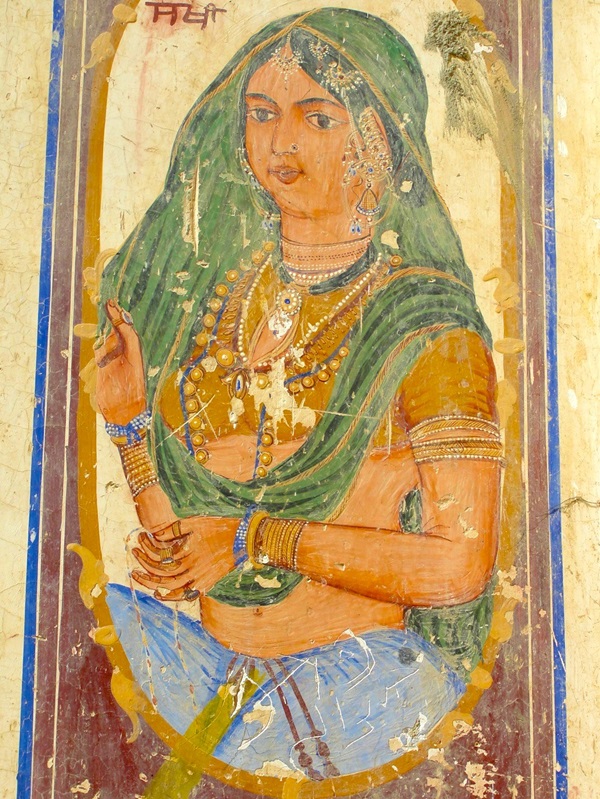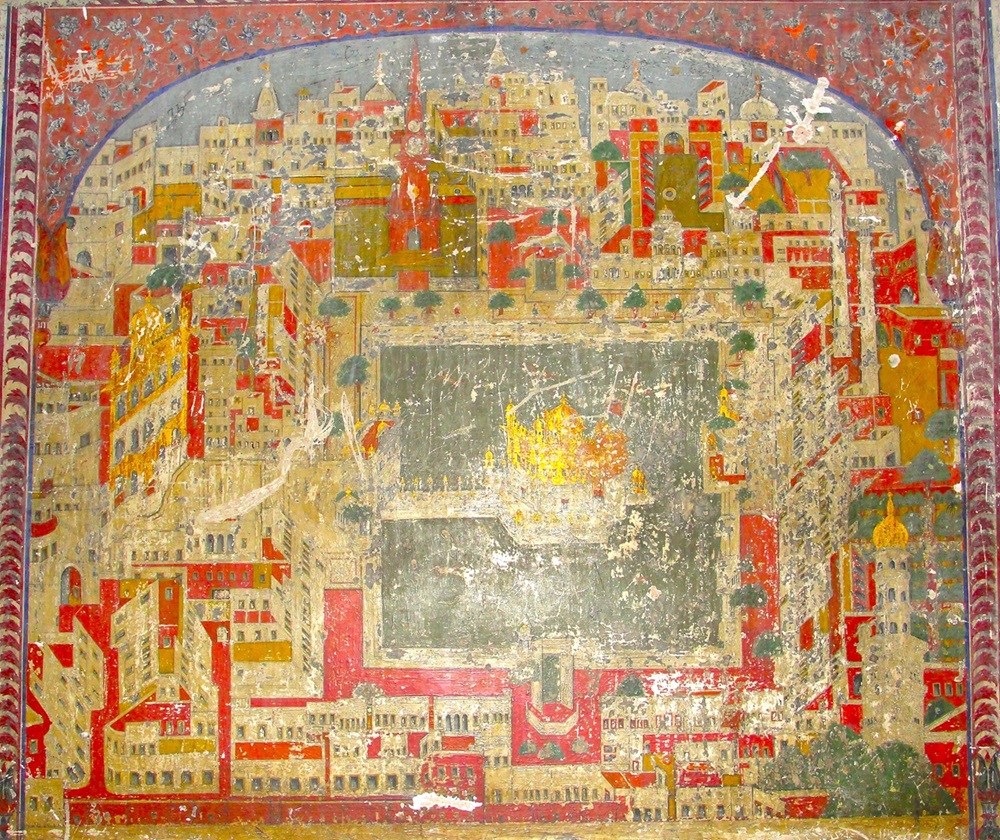Written by: Zulfiqar Ali Kalhoro
Posted on: May 06, 2024 |  | 中文
| 中文
Painted walls of Baba Khem Singh haveli's courtyard (Picture credits to Zulfiqar Ali Kalhoro)
Baba Khem Singh Bedi's Maari, also known as Haveli or Babey da Mahal, is a true marvel in the Pothohar Plateau. What sets it apart from the numerous havelis in Pothohar, including those in Jhelum city, Wah, Rawalpindi city, Chakwal and other towns and villages, is its unmatched ornamentation and unique architectural features.
Baba Khem Singh Bedi was a revered spiritual guide of Sikhs, a notable social reformer, and a prominent landowner, who left an indelible mark on pre-partition Punjab. His haveli in Kallar Syedan, therefore, stands not just as a building, but as a testament to his profound political and religious influence. It was likely constructed in the third quarter of the nineteenth century. According to The Punjab Chiefs by W.L Conran and H.D Craik (1993), Baba Khem Singh Bedi was the son of Atar Singh (d.1839). He had six sons: Gurbakhsh Singh, Hara Singh, Autar Singh, Ujagar Singh, Kartar Singh and Hardit Singh. Baba Khem Singh Bedi was also one of the founders of the Singh Saba movement. He was appointed as a magistrate of Montgomery (Sahiwal) in 1877 and as an honorary munif in 1878. Baba Khem Singh Bedi died in 1905, and his eldest son, Baba Gurbakhsh, succeeded him as the spiritual leader of Sikhs of Pothohar.
The Baba Khem Singh Bedi haveli in Kallar Syedan town, is a striking political symbol of the power he held during the British Raj in Punjab. The haveli, a majestic four-storey structure with many rooms on each storey and three basements, a courtyard and corridors, is a living testament to the skill and craftsmanship of the artisans of colonial Punjab. It is constructed of locally sourced stone, dressed and used by the local masons. The haveli's hallmark lies in its exceptional woodwork and paintings. The intricately crafted wooden jharokhas (a stone or wooden window, projecting from the wall face of a building, in an upper storey, overlooking a street, market, court or any other open space) and doors and ceilings all evoke a deep admiration for the mastery of Pothohari artisans. The two main entrance doors, ornately carved, are a sight to behold. The haveli also features some exquisitely crafted windows above its doorways. The southern doorway, flanked by sitting platforms, opens into a small courtyard. On the left of this courtyard is a jharokha in the assembly hall of the haveli where Baba Khem Singh Bedi used to hold court. This jharokha is particularly noteworthy for its intricate woodcarving. Jharokhas, a common feature in many famous pre-partition havelis in Rawalpindi, Chakwal, Jhelum and Attock, and even some temples are best exemplified by Hari Mandir in Hazro. Atam Singh and Jeevan Singh's havelis were also known for their impressive jharokhas in Gujar Khan's Daultala town. However, the haveli of Atam Sindh Gujral was demolished a couple of years ago, and the haveli of Bakhshi Ram Singh, built in 1886 in Gujar Khan's Kauntrilla, also contains beautiful jharokhas that are now crumbling.
The small courtyard also has a beautifully carved door with three windows above. This doorway opens to the haveli's main courtyard, the walls of which feature depictions of Sikh nobles and Hindu deities, with the most notable being women depicted in various postures. One of the most impressive themes is Nayika, the romantic heroine and her friends. The paintings found in the Pothohar region depict Nayikas adorning themselves, with some looking at their reflections in mirrors, showcasing their impressive decorations. One painting that stands out is the Madanika Darpana, where a heroine admires herself in the mirror. While these paintings are unique to Pothohar, others of Sakhis or Gopis, the cowherd girls who tried to win over Krishna's heart, are also found. Some depictions show the Gopis dancing with Krishna in a few temples in Pothohar. The Kalan Das temple in Rawalpindi's Kohati bazaar features a painting of "Shasaman Sakhi," with an inscription in Gurmukhi above it that reads "Shaaman Sakhi," meaning the romantic interest of Shyam. Krishna is given the name Shyam, because of his dark complexion.

Depiction of Sakhi or Gopi of Krishna in Khem Singh Bedi haveli (Picture credits to Zulfiqar Ali Kalhoro)
Apart from representations of women in various postures, one also notices paintings of Hindu deities with Gurmukhi inscriptions. Lord Vishnu is depicted holding the conch, chakra, discus, club and lotus flower in his four hands. Lord Shiva and his son Ganpati are also shown on the courtyard wall. One also sees the depictions of Ram with his consort devotee Hanuman, and brothers Bharat, Lakshman and Shatrughan. Brahma is also depicted on a wall. Ashtabhuja Mata is a mother with eight hands holding eight different objects in each of her hands. The Gurmukhi inscription also supports this image. The other Hindu deities are also depicted, including Shiva, Bhairon, Ganga Mata and Saraswati Mata. The images of Naths are also painted. The images of Sikh soldiers, Hindu kings, notably Raja Bhagirath, sages, Sidhs, Naths, Pandavas, chiefly Arjan, all reflect the syncretic tradition prevalent in pre-partition Punjab.
After the partition of 1947, the haveli was used as Government Boys High School Kallar Syedan for many decades. The schoolboys vandalized several figures and wrote their names on some of the panels in the khawabgah, a retiring room. This room is decorated with panels that depict the ten Sikh gurus. The first panel portrays Baba Guru Nanak along with his companion, Bhai Bala. Another panel shows Guru Angad, while the third and fourth panels represent Guru Amar Das and Guru Ram Das, respectively. The fourth, sixth and seventh panels show Guru Arjan, Guru Hargobind, and Guru Har Rai. The eighth, ninth and tenth panels depict Guru Har Krishan, Guru Tegh Bahadur, and Guru Gobind Singh. In the haveli, there are a few painted rooms that stand out. One of them has a representation of the Golden Temple of Amritsar, which showcases the mastery of Pothohari painters in creating religious images on walls of mansions. This type of religious imagery cannot be found in any other haveli in the Pothohar region. Another room in the haveli depicts the veneration of Baba Atal, who was the son of Guru Hargobind.

Depiction of Golden Temple Amritsar in Baba Khem Singh haveli (Picture credits to Zulfiqar Ali Kalhoro)
On the premises of the haveli is Hotey Shah's grave. A broken plaque with an Urdu inscription reads Hotey Shah Mardan. On a slab of the grave is a Gurmukhi inscription that says Ram Singh donated it in 1914. Unfortunately, the wooden doors and windows of the haveli have started to crumble, and the paintings are also in an advanced stage of decay. It's important that these unique features are restored, and the haveli is converted into a museum to showcase the rich cultural heritage of the Pothohar region.
The writer is an anthropologist. He has authored 15 books on Pakistan's cultural heritage and anthropology. He tweets @kalhorozulfiqar
You may also like: